Comparing Precipitation during Typhoons in the Western North Pacific Using Satellite and In Situ Observations
Abstract
:1. Introduction
- Long data records—Provides daily precipitation data from 1983 to the present;
- Large spatial coverage—Quasi-global (60°S–60°N; 180°W–180°E) spatial coverage and 0.25° × 0.25° spatial resolution;
- Proven use in variety of environments—Used for estimating precipitation around the world in varied topographical areas, complex terrains, and over oceans;
- Tested across years—Widely used (more than 2000 publications) and easily accessible to the public;
- Verification and validation—It has been corrected using an in situ gauge network.
- 10+ year record—Provides daily precipitation data from 1998 to 2019;
- Large spatial coverage—Quasi-global (50°S to 50°N; 180°W to 180°E) spatial coverage and 0.25° × 0.25° spatial resolution;
- Proven use in a variety of environments and for tropical cyclones—Used for estimating precipitation around the world in varied topographical areas, complex terrain, and over oceans;
- Tested across years—Widely used (more than 160 publications since 2007) and easily accessible to the public;
- Verification and validation—It has been corrected using an in situ gauge network at the monthly scale.
2. Methods
3. Results
3.1. Rates of Occurrence of Typhoons Changed over Time from 1959 to Present Day
3.2. Comparison of Precipitation Results between In Situ Gauges and Satellite Remote Sensing Estimates in the Western North Pacific
3.3. Comparison of Precipitation Results between In Situ Gauges and Satellite Remote Sensing Estimates during Typhoons
3.4. Comparison of Precipitation Results between In Situ Gauges and Satellite Remote Sensing Estimates during a Specific Typhoon
4. Discussion
Author Contributions
Funding
Institutional Review Board Statement
Informed Consent Statement
Acknowledgments
Conflicts of Interest
References
- Galloway, J.N.; Cowling, E.B. The effects of precipitation on aquatic and terrestrial ecosystems: A proposed precipitation chemistry network. J. Air Pollut. Control Assoc. 1987, 28, 229–235. [Google Scholar] [CrossRef] [Green Version]
- Lobell, D.B.; Schlenker, W.; Costa-Roberts, J. Climate trends and global crop production since 1980. Science 2011, 333, 616–620. [Google Scholar] [CrossRef] [PubMed] [Green Version]
- Alexander, L.V.; Zhang, X.; Peterson, T.C.; Caesar, J.; Gleason, B.; Klein Tank, A.M.G.; Haylock, M.; Collins, D.; Trewin, B.; Rahimzadeh, F.; et al. Global observed changes in daily climate extremes of temperature and precipitation. J. Geophys. Res. Atmos. 2006, 111, D05109. [Google Scholar] [CrossRef] [Green Version]
- Strangeways, I. A history of rain gauges. Weather 2010, 65, 311. [Google Scholar] [CrossRef]
- Karl, T.R.; Knight, R.W.; Plummer, N. Trends in high-frequency climate variability in the twentieth century. Nature 1995, 377, 217–220. [Google Scholar] [CrossRef]
- Xie, P.; Arkin, P.A. Global precipitaiton: A 17-year monthly analysis based on gauge observations satellite estimates and numerical model outputs. Bull. Am. Meterol. Soc. 1997, 78, 2539–2558. [Google Scholar] [CrossRef]
- Hou, A.Y.; Kakar, R.K.; Neeck, S.; Azarbarzin, A.A.; Kummerow, C.D.; Kojima, M.; Oki, R.; Nakamura, K.; Iguchi, T. The global precipitation measurement mission. Bull. Am. Meterol. Soc. 2014, 95, 701–722. [Google Scholar] [CrossRef]
- Kummerow, C.; Barnes, W.; Kozu, T.; Shiue, J.; Simpson, J. The tropcial rainfall measuring mission (TRMM TMPA) sensor package. J. Atmos. Ocean. Technol. 1998, 15, 809–817. [Google Scholar] [CrossRef]
- Sorooshian, S.K.; Aghakouchak, A.; Arkin, P.; Eylander, J.; Foufoula-Georgiou, E.; Harmon, R.; Hendrickx, J.M.; Imam, B.; Kuligowski, R.; Skahill, B.; et al. Advancing the remote sensing of precipitation. Bull. Am. Meteorol. Soc. 2011, 92, 1271–1272. [Google Scholar] [CrossRef]
- Sorooshian, S.; Hsu, K.; Braithwaite, D.; Ashouri, H. NOAA Climate Data Record (CDR) of Precipitation Estimation from Remotely Sensed Information Using Artificial Neural Networks (PERSIANN-CDR), Version 1, Revision 1; NOAA National Centers for Environmental Information: Boulder, CO, USA, 2014. Available online: https://www.ncei.noaa.gov/metadata/geoportal/rest/metadata/item/gov.noaa.ncdc:C00854/html# (accessed on 22 September 2020).
- Ebert, E.E.; Janowiak, J.E.; Kidd, C. Comparison of near-real-time precipitaiton estimates from satellite observations and numerical models. Bull. Am. Meteorol. Soc. 2007, 88, 47–64. [Google Scholar] [CrossRef] [Green Version]
- Chen, M.; Xie, P.; Janowiak, J.E.; Arkin, P. Global land precipitation: A 50-yr monthly analysis based on gauge observations. J. Hydrometeorol. 2002, 3, 249–266. [Google Scholar] [CrossRef]
- Le, H.M.; Sutton, J.R.; Bui, D.D.; Bolten, J.D.; Lakshmi, V. Comparison and bias correction of TMPA precipitaiton products over the lower part of Red-Thai Binh River Basin of Vietnam. Remote Sens. 2018, 10, 1582. [Google Scholar] [CrossRef] [Green Version]
- Ashouri, H.; Hsu, K.; Sorooshian, S.; Braithwaite, D.K.; Knapp, K.R.; Cecil, L.D.; Nelson, B.R.; Prat, O.P. PERSIANN-CDR: Daily precipitation climate data record for mulisatellite observations for hydrological and climate studies. Bull. Am. Meteorol. Soc. 2015, 96, 69–83. [Google Scholar] [CrossRef] [Green Version]
- Michaelides, S.; Levizzani, V.; Anagnostou, E.; Bauer, P.; Kasparis, T.; Lane, J.E. Precipitation: Measurement, remote sensing, climatology and modeling. Atmos. Res. 2009, 94, 512–533. [Google Scholar] [CrossRef]
- Pollock, M.D.; O’Donnell, G.; Quinn, P.; Dutton, M.; Black, A.; Wilkinson, M.E.; Colli, M.; Stagnaro, M.; Lanza, L.G.; Lewis, E.; et al. Quantifying and mitigating wind—Induced undercatch in rainfall measurements. Water Resour. Res. 2018, 54, 3863–3875. [Google Scholar] [CrossRef]
- Wu, W.; McInnes, K.; O’Grady, J.; Hoeke, R.; Leonard, M.; Westra, S. Mapping dependence between extreme rainfall and storm surge. J. Geophys. Res. Oceans 2018, 123, 2461–2474. [Google Scholar] [CrossRef]
- Bartsotas, N.S.; Anagnostou, E.N.; Nikolopoulos, E.L.; Kallos, G. Investigating satellite precipitation uncertainity over complex terrain. J. Geophys. Res. Atmos. 2018, 123, 5346–5359. [Google Scholar] [CrossRef]
- Petty, G.W.; Krajewski, W.F. Satellite estimation of precipitaiton over land. Hydrol. Sci. 1996, 4, 433–451. [Google Scholar] [CrossRef]
- Nguyen, P.; Sellars, S.; Thorstensen, A.; Tao, Y.; Ashouri, H.; Braithwaite, D.; Hsu, K.; Sorooshian, S. Satellites track precipitation of super typhoon Haiyan. Eos 2014, 95, 133–135. [Google Scholar] [CrossRef]
- Lonfat, M.; Marks, F.D.; Chen, S.S. Precipitation distribution in tropical cyclones using the tropical rainfall measuring mission (TRMM TMPA) microwave imager: A global prespective. Mon. Weather Rev. 2004, 132, 1645–1660. [Google Scholar] [CrossRef]
- Feng, X.; Shu, S. How do weak tropical cyclones produce heavy rainfall when making landfall over China. J. Geophys. Res. Atmos. 2018, 123, 830–848. [Google Scholar] [CrossRef]
- Guzman, O.; Jiang, H. Global increase in tropical cyclone rain rate. Nat. Commun. 2021, 12, 5344. [Google Scholar] [CrossRef] [PubMed]
- Holden, W.; Marshall, S.J. Chapter 24—Climate change and typhoons in the Philippines: Extreme weather events in the Anthropocene. In Integrating Disaster Science and Management; Elsevier: Cambridge, MA, USA, 2018; pp. 407–421. [Google Scholar]
- Kang, N.Y.; Elsner, J.B. Climate mechanism for strong typhoons in a warmer world. J. Clim. 2016, 29, 1051–1057. [Google Scholar] [CrossRef] [Green Version]
- Bushnell, J.M.; Cherrett, R.C.; Falvey, R.J. Annual Tropical Cyclone Report. 2018. Available online: http://www.metoc.navy.mil/jtwc/products/atcr/2018atcr.pdf (accessed on 7 June 2021).
- Chu, J.H.; Levine, A.; Daida, S.; Schiber, D.; Fukada, E.; Sampson, C.R. Western North Pacific Ocean Best Track Data. Available online: https://www.metoc.navy.mil/jtwc/jtwc.html?western-pacific (accessed on 4 February 2020).
- Frank, W.M. The structure and energetics of the tropical cyclone. Part I: Storm structure. Mon. Weather Rev. 1977, 105, 1119–1135. [Google Scholar] [CrossRef]
- Holland, G.J. The maximum potential intensity of tropical cyclones. J. Atmos. Sci. 1997, 54, 2519–2541. [Google Scholar] [CrossRef]
- Miller, B.I. Rainfall rates in Florida hurricanes. Mon. Weather Rev. 1958, 86, 258–264. [Google Scholar] [CrossRef]
- Lawrimore, J.H.; Menne, M.J.; Gleason, B.E.; Williams, B.E.; Wuertz, C.N.; Vose, R.S.; Rennie, J. Global historical climatology network—Monthly (GHCN-M), Version 3. J. Geophys. Res. Atmos. 2011, 116, D19121. [Google Scholar] [CrossRef]
- Goddard Earth Sciences Data and Information Services Center. TRMM TMPA Near Real-Time Precipitation L3 1 Day 0.25 Degree X 0.25 Degree V7; Goddard Earth Sciences Data and Information Services Center (GES DISC): Greenbelt, MD, USA, 2016.
- Sorooshian, S.; Hsu, K.-L.; Gao, X.; Gupta, H.V.; Imam, B.; Braithwaite, D. Evaluation of PERSIANN system satellite–based estimates of tropical rainfall. Bull. Am. Meteorol. Soc. 2000, 81, 2035–2046. [Google Scholar] [CrossRef] [Green Version]
- Janowiak, J.E.; Kousky, V.E.; Joyce, R.J. Diurnal cycle of precipitation determined from the CMORPH high spatial and temporal resolution global precipitation analysis. J. Geophys. Res. 2005, 110, 2005. [Google Scholar]
- Su, F.; Hong, Y.; Lettenmaier, D.P. Evaluation of TRMM multisatellite precipitation analysis (TMPA) and its utility in hydrologic prediction in the La Plata Basin. J. Hydrometeorol. 2008, 9, 622–640. [Google Scholar] [CrossRef] [Green Version]
- Koo, M.S.; Hong, S.Y.; Kim, J. An evaluation of the tropical rainfall measuring mission (TRMM TMPA) multi-satellite precipitation analysis (TMPA) data over South Korea. Asia Pac. J. Atmos. Sci. 2009, 45, 256–282. [Google Scholar]
- Huffman, G.J.; Bolvin, D.T.; Nelkin, E.J.; Wolff, B.D.; Adler, R.F.; Gu, G.; Hong, Y.; Bowman, K.P.; Stocker, E.F. The TRMM TMPA multisatellite precipitation analysis (TMPA): Quasi-global, multiyear, combined-sensor precipitation estimates at fine scales. J. Hydrometerol. 2007, 8, 38–55. [Google Scholar] [CrossRef]
- Jiang, H.; Zipser, E.J. Contribution of tropical cyclones to the global precipitation from eight seasons of TRMM TMPA data: Regional, seasonal, and interannual variations. J. Clim. 2010, 23, 1526–1543. [Google Scholar] [CrossRef]
- Ayugi, B.; Tan, G.; Ullah, W.; Boiyo, R.; Ongoma, V. Inter-comparison of remotely sensed precipitation datasets over Kenya during 1998–2016. Atmos. Res. 2019, 225, 96–109. [Google Scholar] [CrossRef]
- Stowasser, M.; Wang, Y.; Hamilton, K. Tropical cyclone changes int the Western North Pacific in a global warming scenario. J. Clim. 2007, 20, 2378–2396. [Google Scholar] [CrossRef] [Green Version]
- Chan, J.C. Decadal variations of intense typhoon the western North Pacific. Proc. R. Soc. 2008, 464, 249–272. [Google Scholar] [CrossRef]
- Latif, M.; Barnett, T.P. Causes of decadal climate variability over the North Pacific and North America. Science 1994, 266, 634–637. [Google Scholar] [CrossRef] [Green Version]
- Rodgers, E.B.; Adler, R.F.; Pierce, H.F. Contribution of tropical cyclones to the North Pacific climatological rainfall as observed from satellites. J. Appl. Meteorol. 2000, 39, 1658–1678. [Google Scholar] [CrossRef] [Green Version]
- Tu, J.-Y.; Chou, C. Changes in precipitation frequency and intensity in the vicinity of Taiwan: Typhoon versus non-typhoon events. Environ. Res. Lett. 2013, 8, 14023. [Google Scholar] [CrossRef]
- Chu, P.-S.; Chen, D.-J.; Lin, P.-L. Trends in precipitation extremes during the typhoon season in Taiwan over the last 60 years. Atmos. Sci. Lett. 2013, 15, 37–43. [Google Scholar] [CrossRef]
- Yang, S.; Lao, V.; Bankert, R.; Whitcomb, T.R.; Cossuth, J. Improved climatology of tropical cyclone precipitation from satellite passive microwave measurements. J. Clim. 2021, 34, 4521–4537. [Google Scholar] [CrossRef]
- Libertino, A.; Sharma, A.; Lakshmi, V.; Claps, P. A global assessment of the timing of extreme rainfall from TRMM and GPM for improving hydrologic design. Environ. Res. Lett. 2016, 11, 54003. [Google Scholar] [CrossRef]
- Hashemi, H.; Nordin, M.; Lakshmi, V.; Huffman, G.; Knight, R. Bias correction of long-term satellite monthly precipitation product (TRMM 3B43) over the conterminous United States. J. Hydrometeorol. 2017, 18, 2491–2509. [Google Scholar] [CrossRef]
- Mondal, A.; Lakshmi, V.; Hashemi, H. Intercomparison of trend analysis of multi-satellite monthly precipitation products and gage measurements for river basins of India. J. Hydrol. 2018, 565, 779–790. [Google Scholar] [CrossRef]
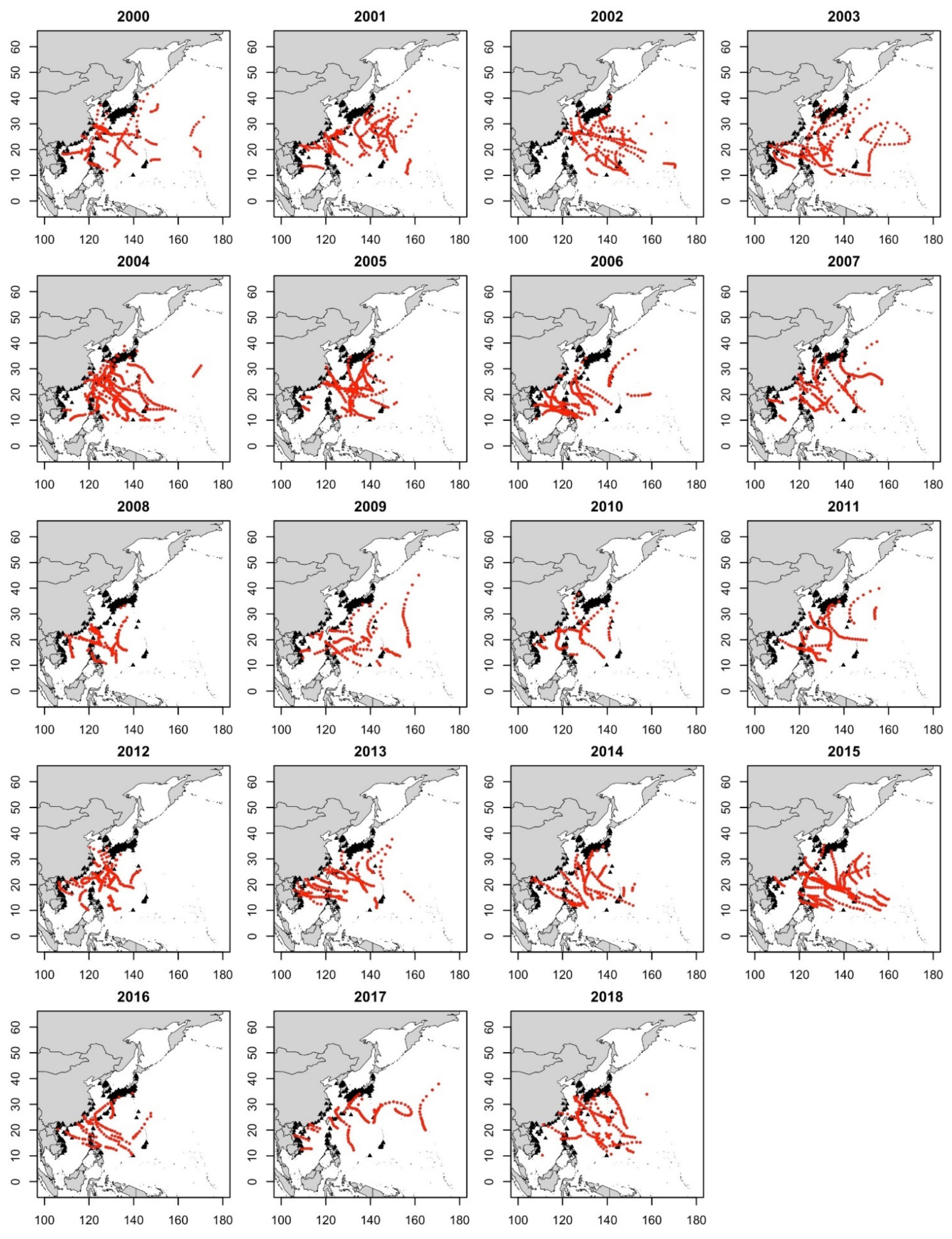
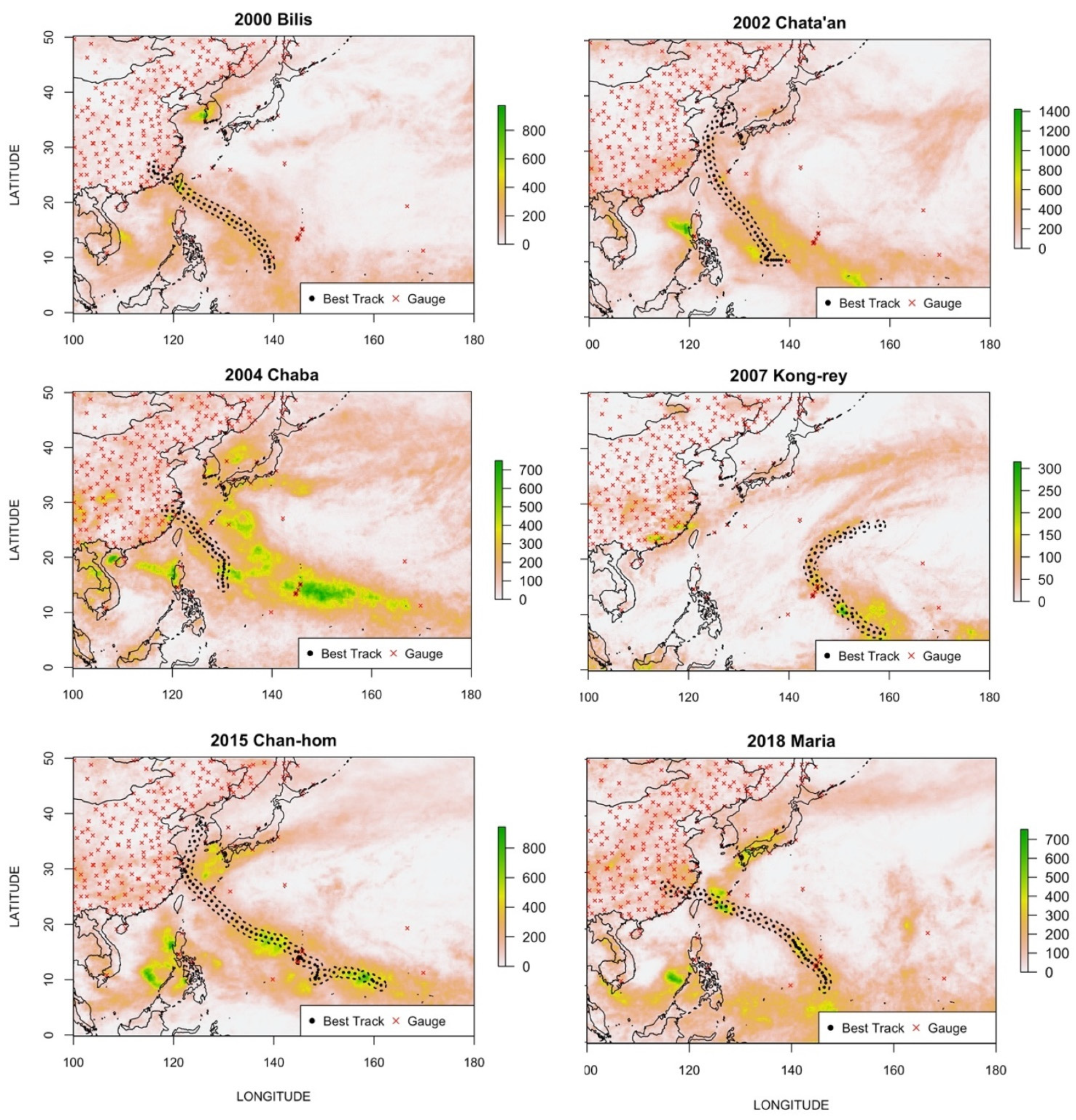
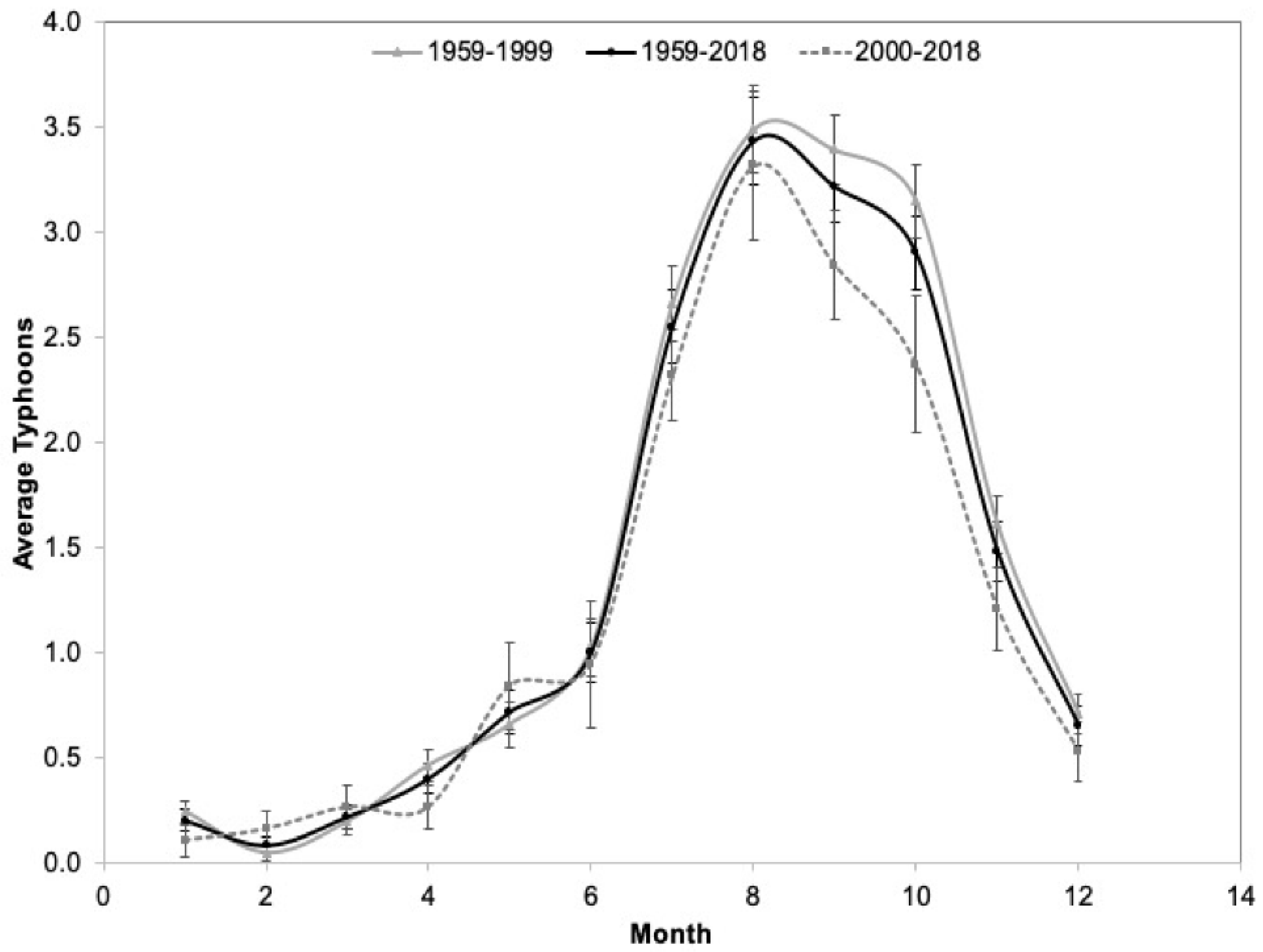

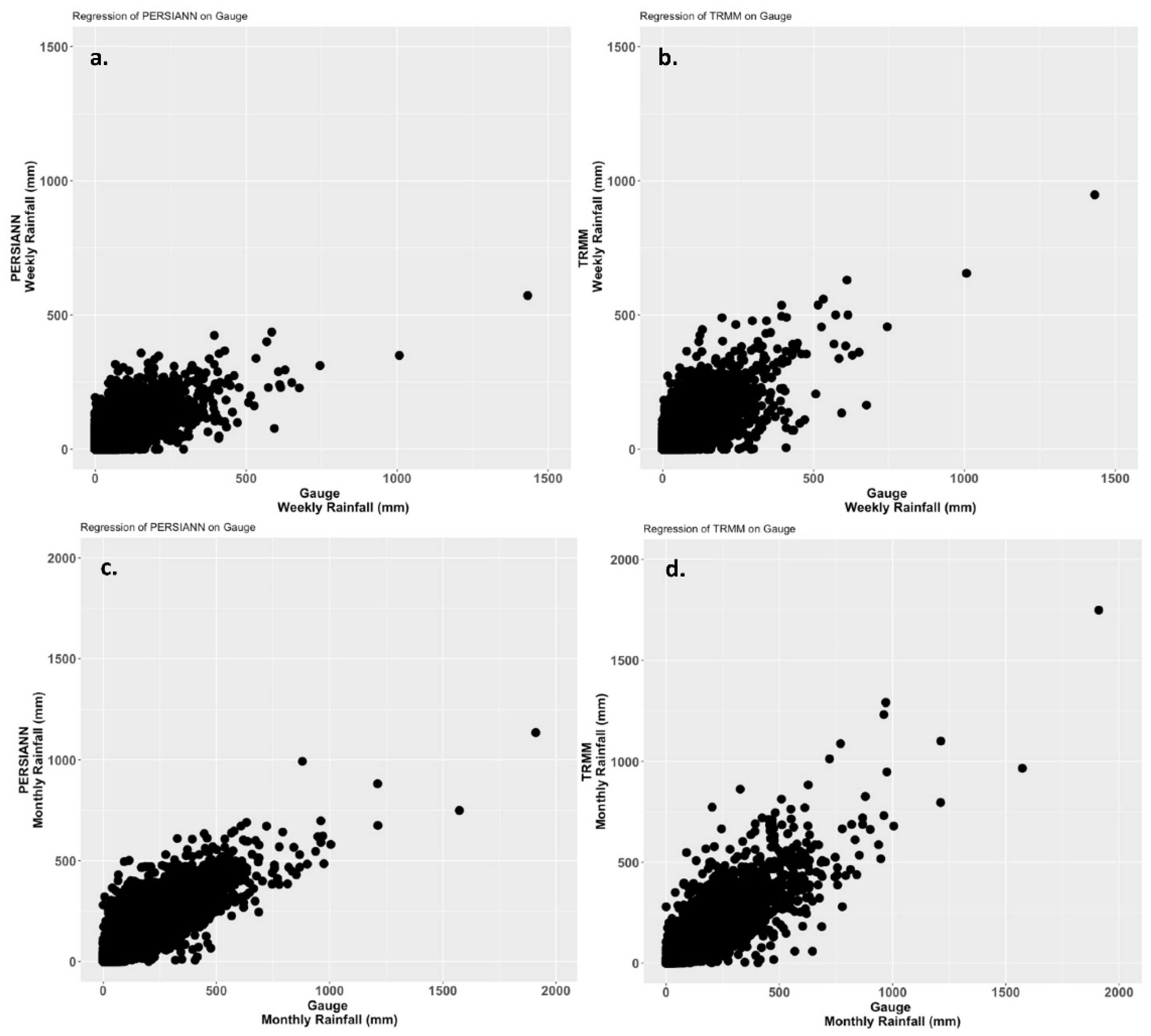
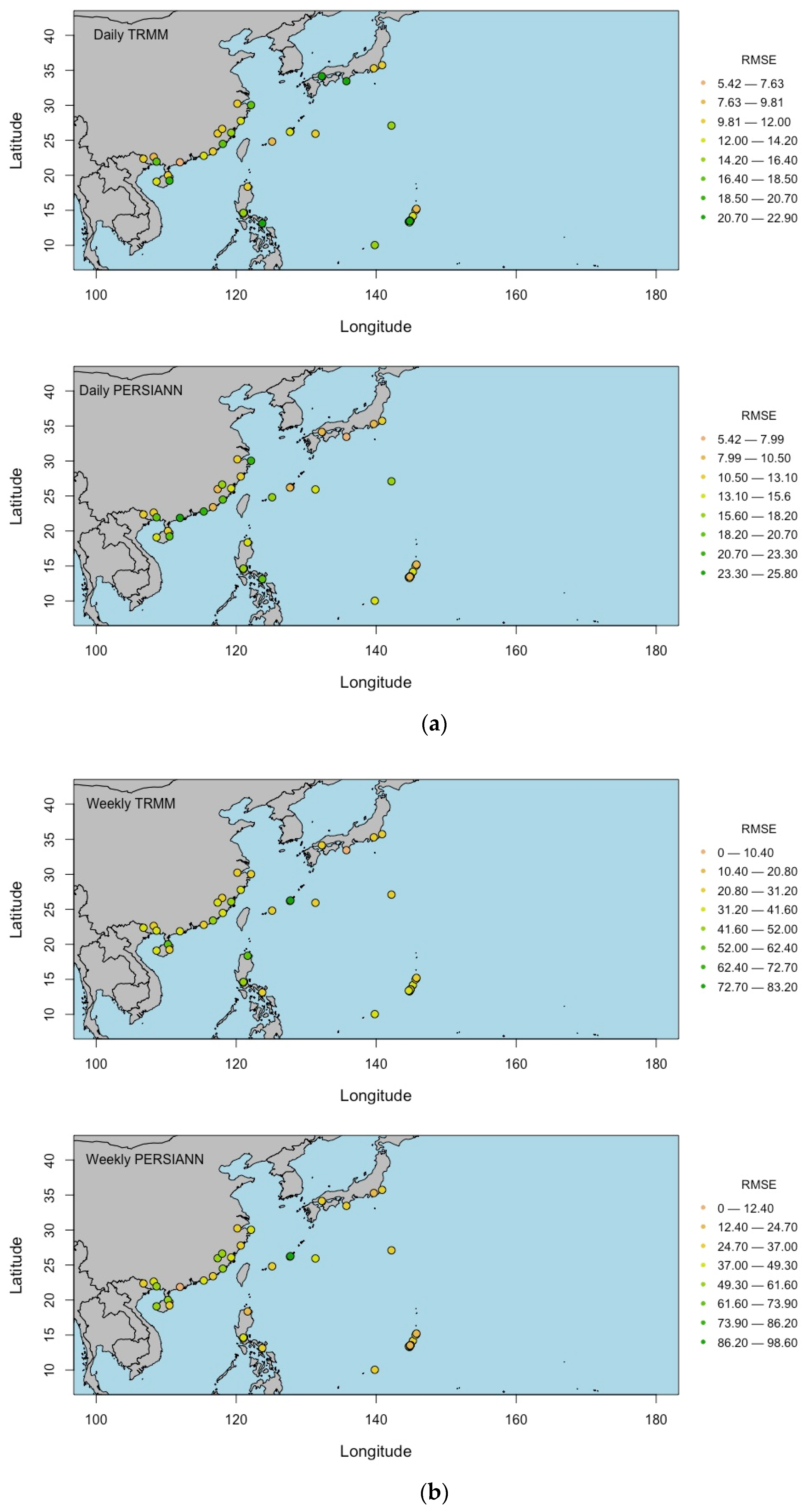
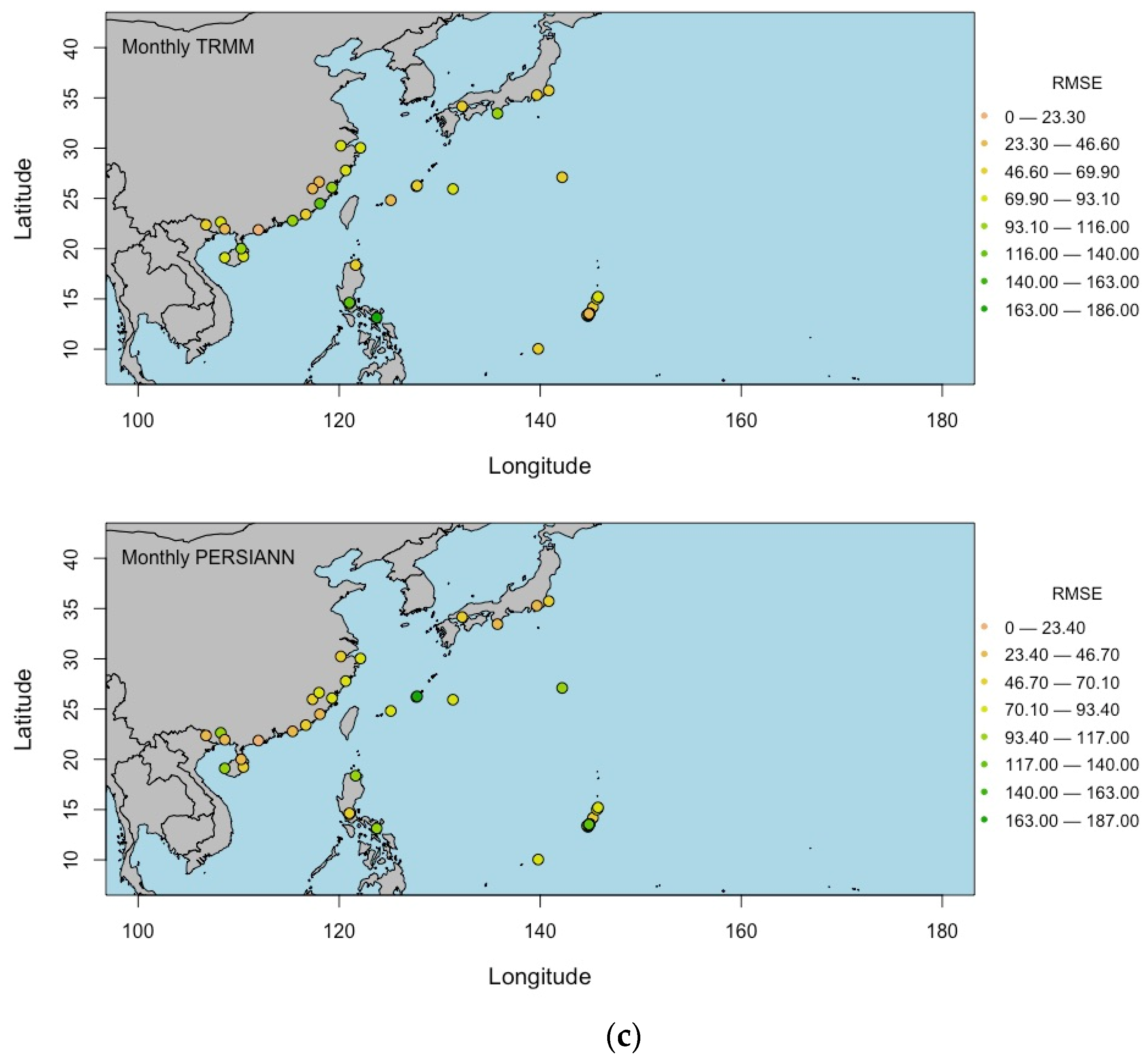
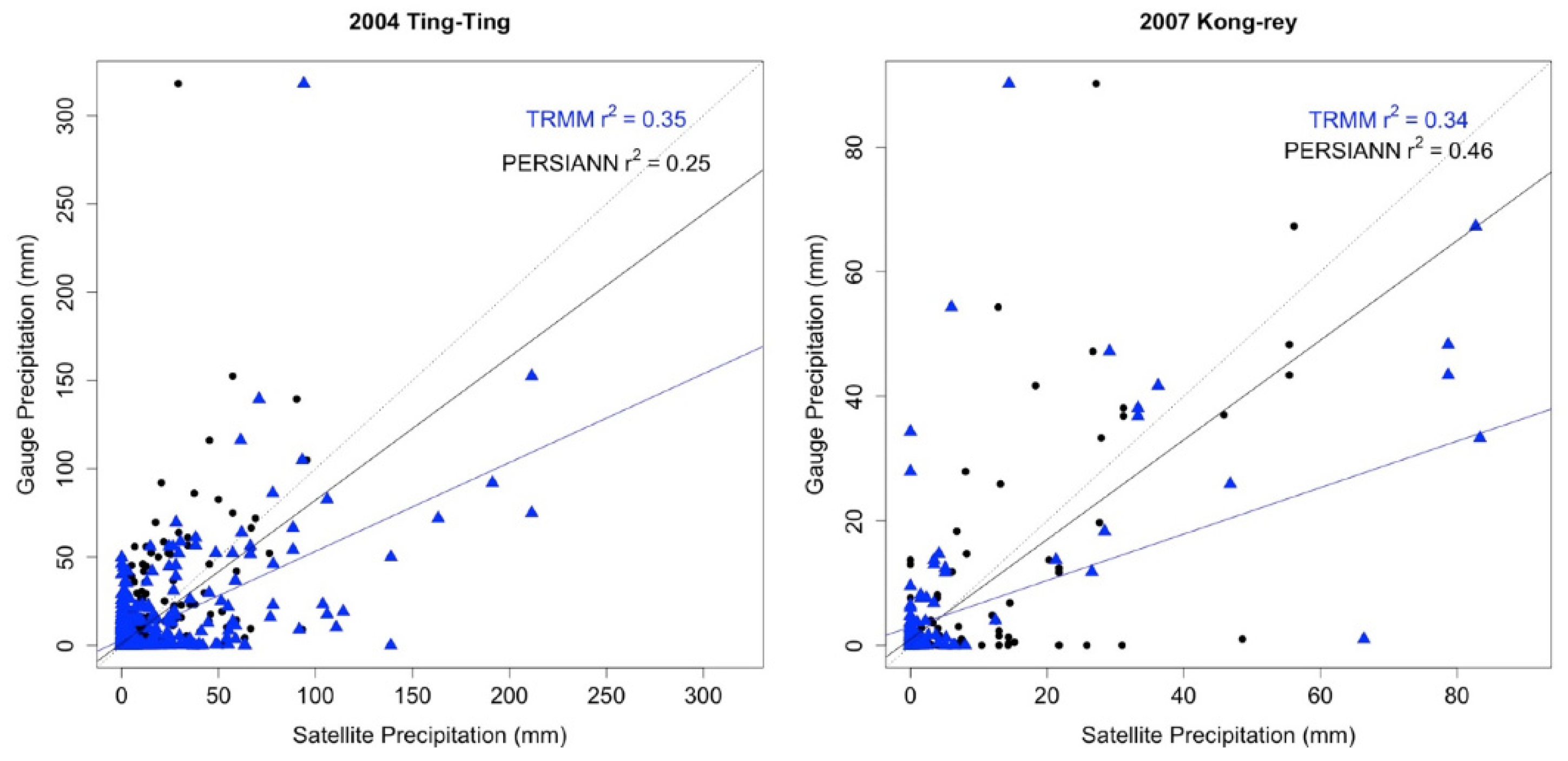
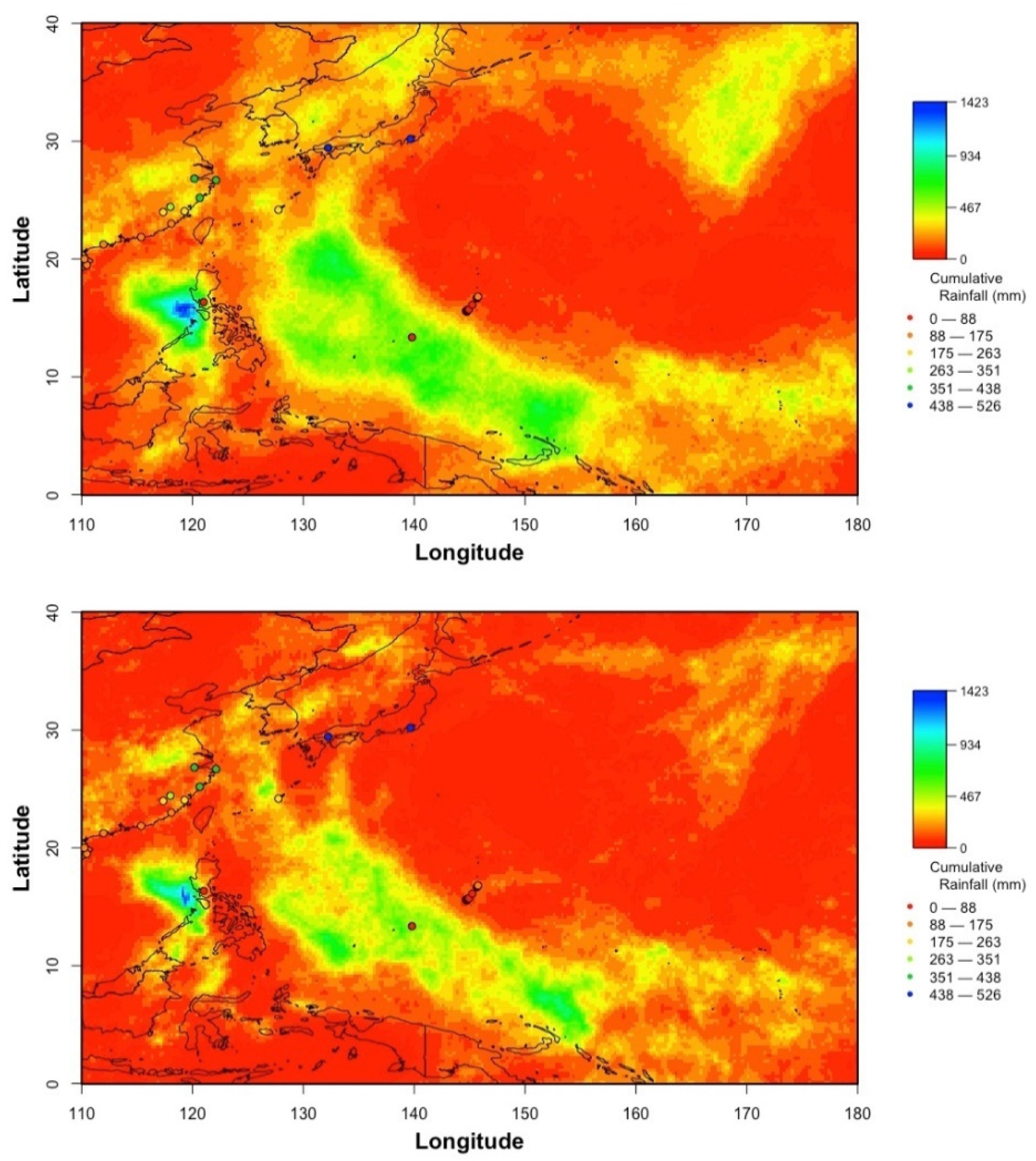
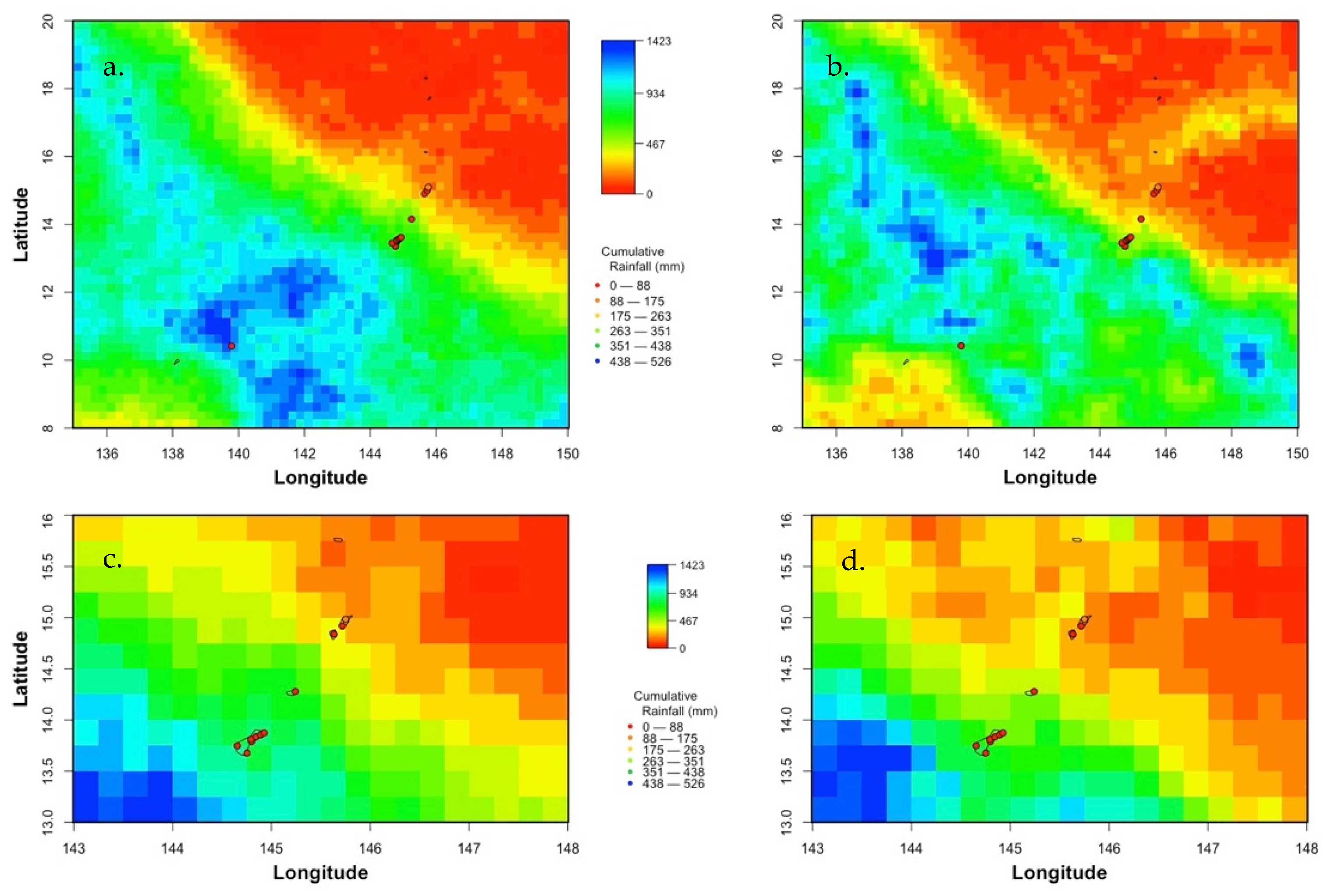
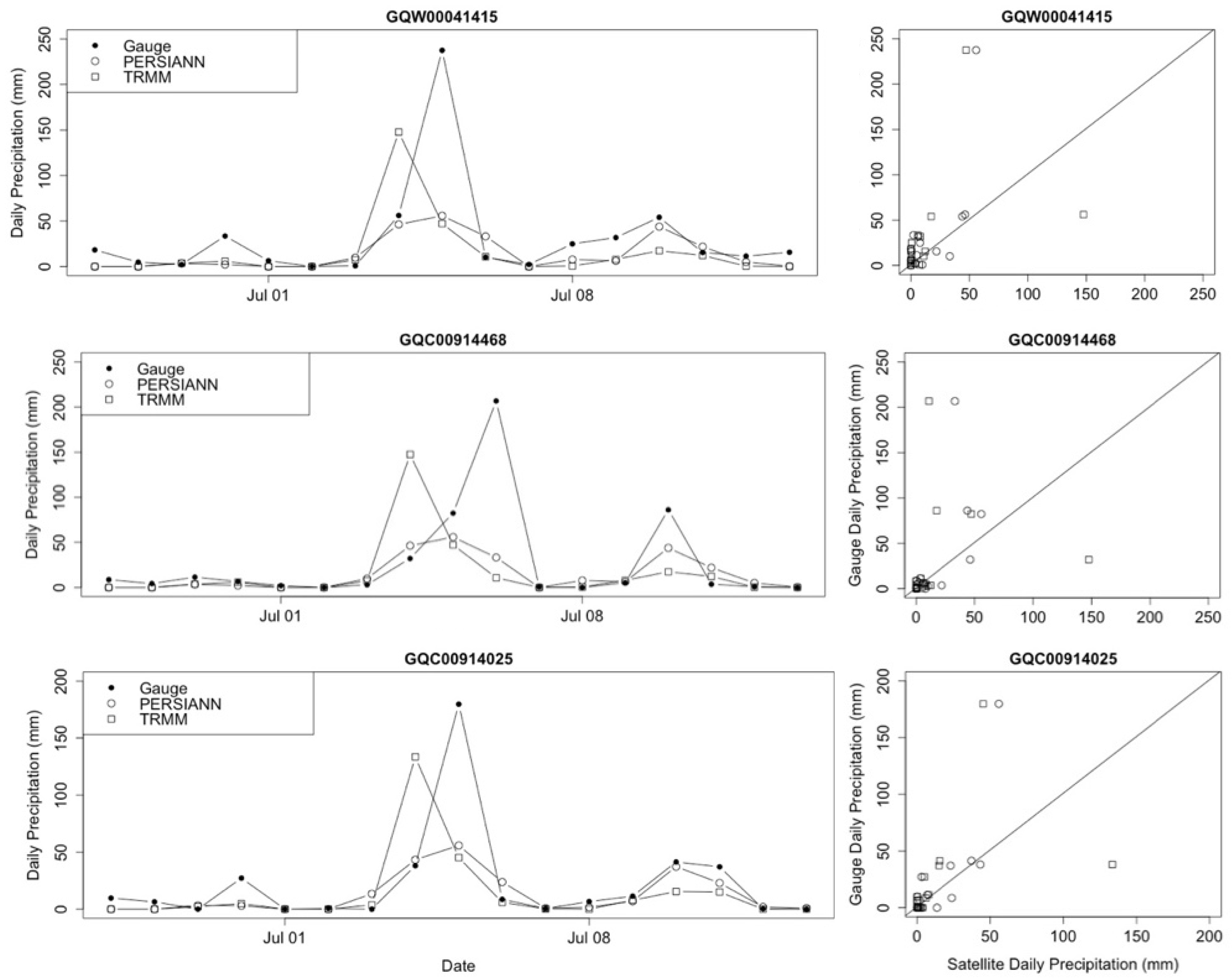

| Year | Month | Duration | Name | ONI |
|---|---|---|---|---|
| 2000 | August | 10 | Bilis | −0.5 |
| 2002 | June, July | 17 | Chata’an | 0.7, 0.8 |
| 2002 | July | 15 | Halong | 0.8 |
| 2002 | December | 11 | Pongsona | 1.1 |
| 2003 | April | 22 | Kujira | 0.0 |
| 2004 | April | 17 | Sudal | 0.2 |
| 2004 | June, July | 17 | Ting Ting | 0.3, 0.5 |
| 2004 | August, September | 19 | Chaba | 0.6, 0.7 |
| 2007 | March, April | 7 | Kong-rey | 0.0, −0.2 |
| 2008 | December | 10 | Dolphin | −0.7 |
| 2009 | September | 5 | Ketsana | 0.7 |
| 2013 | October | 12 | Francisco | −0.2 |
| 2013 | November | 9 | Haiyan | −0.2 |
| 2014 | July | 12 | Neoguri | 0.1 |
| 2014 | July, August | 20 | Halong | 0.1, 0.0 |
| 2015 | May | 19 | Dolphin | 1.0 |
| 2015 | June, July | 15 | Chan-hom | 1.2, 1.5 |
| 2016 | July | 7 | Nepartak | −0.3 |
| 2017 | October | 9 | Lan | −0.9 |
| 2018 | March, April | 10 | Jelawat | −0.6, −0.5 |
| 2018 | June, July | 9 | Prapiroon | 0.1 |
| 2018 | July | 10 | Maria | 0.1 |
| 2018 | July | 6 | Wukong | 0.1 |
| 2018 | August | 10 | Soulik | 0.1 |
| 2018 | August | 8 | Cimaron | 0.1 |
| Station ID | Latitude | Longitude | Elevation (m) | Gauge (mm/Year) |
|---|---|---|---|---|
| CHM00059838 | 19.10 | 108.62 | 8 | 1072 |
| CHM00059417 | 22.37 | 106.75 | 129 | 1182 |
| CHM00059316 | 23.40 | 116.68 | 3 | 1208 |
| CHM00059431 | 22.63 | 108.22 | 126 | 1231 |
| JAW00043323 | 35.28 | 139.67 | 53 | 1245 |
| CHM00059134 | 24.48 | 118.08 | 18 | 1299 |
| CHM00058457 | 30.23 | 120.17 | 43 | 1364 |
| JA000047648 | 35.73 | 140.85 | 28 | 1383 |
| CHM00058477 | 30.03 | 122.12 | 37 | 1386 |
| CHM00058847 | 26.08 | 119.28 | 14 | 1416 |
| JAW00043324 | 34.15 | 132.23 | 3 | 1484 |
| CHM00058921 | 25.97 | 117.35 | 204 | 1555 |
| CHM00058834 | 26.63 | 118.00 | 128 | 1589 |
| JA000047971 | 27.10 | 142.18 | 8 | 1633 |
| CHM00058752 | 27.78 | 120.65 | 38 | 1650 |
| GQC00914156 | 13.52 | 144.85 | 107 | 1680 |
| CQC00914855 | 15.12 | 145.72 | 66 | 1802 |
| JAW00042215 | 26.27 | 127.75 | 84 | 1819 |
| GQC00914950 | 13.55 | 144.89 | 160 | 1867 |
| CHM00059758 | 20.00 | 110.25 | 24 | 1870 |
| CHM00059501 | 22.78 | 115.37 | 5 | 1872 |
| CQC00914874 | 15.00 | 145.63 | 82 | 1939 |
| RP000098232 | 18.37 | 121.63 | 3 | 2079 |
| CHM00059632 | 21.95 | 108.62 | 6 | 2109 |
| GQC00914727 | 13.35 | 144.77 | 3 | 2151 |
| CHM00059855 | 19.23 | 110.47 | 25 | 2170 |
| CHM00059663 | 21.87 | 111.97 | 22 | 2280 |
| JA000047927 | 24.82 | 125.13 | 16 | 2319 |
| JA000047945 | 25.93 | 131.32 | 24 | 2327 |
| CQC00914080 | 15.21 | 145.75 | 252 | 2350 |
| CQC00914801 | 14.17 | 145.24 | 179 | 2384 |
| GQC00914025 | 13.58 | 144.93 | 190 | 2469 |
| GQC00914001 | 13.39 | 144.66 | 3 | 2492 |
| GQC00914468 | 13.45 | 144.80 | 18 | 2498 |
| JA000047778 | 33.45 | 135.75 | 76 | 2545 |
| GQW00041415 | 13.48 | 144.80 | 77 | 2554 |
| JA000047936 | 26.20 | 127.68 | 53 | 2651 |
| FMC00914892 | 10.03 | 139.80 | 2 | 2843 |
| RP000098430 | 14.63 | 121.02 | 46 | 4077 |
| RP000098444 | 13.13 | 123.73 | 17 | 4702 |
| Statistic | Parameters | Cumulative Precipitation | ||
|---|---|---|---|---|
| Day (mm/d)_ | Week (mm/w) | Month (mm/m) | ||
| CC | TRMM TMPA | 0.412 | 0.754 | 0.825 |
| PERSIANN | 0.430 | 0.691 | 0.803 | |
| r2 | Gauge = m ∗ TRMM TMPA + b | 0.170 | 0.568 | 0.680 |
| Gauge = m ∗ PERSIANN + b | 0.185 | 0.478 | 0.645 | |
| Gauge = m ∗ TRMM TMPA + Station + b | 0.178 | 0.587 | 0.725 | |
| Gauge = m ∗ PERSIANN + Station + b | 0.195 | 0.511 | 0.726 | |
| RMSE | Gauge = m ∗ TRMM TMPA + b | 13.707 | 35.870 | 85.148 |
| Gauge = m ∗ PERSIANN + b | 13.588 | 39.436 | 89.727 | |
| Gauge = m ∗ TRMM TMPA + Station + b | 13.641 | 39.060 | 78.502 | |
| Gauge = m ∗ PERSIANN + Station + b | 13.501 | 38.170 | 78.407 | |
| Storm | TRMM TMPA | PERSIANN | DF | # of Stations |
|---|---|---|---|---|
| 2000 Bilis | 0.327 | 0.214 | 330 | 34 |
| 2002 Chata’an | 0.081 | 0.230 | 457 | 31 |
| 2002 Halong | 0.125 | 0.207 | 398 | 29 |
| 2002 Pongsona | 0.038 | 0.083 | 298 | 30 |
| 2003 Kujira | 0.144 | 0.073 | 602 | 30 |
| 2004 Sudal | 0.092 | 0.040 | 440 | 28 |
| 2004 Ting-Ting | 0.349 | 0.251 | 463 | 28 |
| 2004 Chaba | 0.299 | 0.302 | 501 | 29 |
| 2007 Kong-rey | 0.344 | 0.459 | 172 | 26 |
| 2008 Dolphin | 0.094 | 0.201 | 228 | 26 |
| 2009 Ketsana | 0.012 | 0.004 | 121 | 27 |
| 2013 Francisco | 0.042 | 0.354 | 46 | 4 |
| 2013 Haiyan | 0.004 | 0.011 | 34 | 4 |
| 2014 Neoguri | 0.044 | 0.278 | 99 | 9 |
| 2014 Halong | 0.233 | 0.331 | 171 | 9 |
| 2015 Dolphin | 0.042 | 0.091 | 154 | 9 |
| 2015 Chan-hom | 0.072 | 0.099 | 120 | 9 |
| 2016 Nepartak | 0.023 | 0.000 | 55 | 9 |
| 2017 Lan | 0.037 | 0.046 | 73 | 9 |
| 2018 Jelewat | 0.115 | 0.217 | 74 | 11 |
| 2018 Prapiroon | 0.143 | 0.093 | 66 | 11 |
| 2018 Maria | 0.260 | 0.340 | 84 | 11 |
| 2018 Wukong | 0.025 | 0.072 | 46 | 9 |
| 2018 Soulik | 0.077 | 0.238 | 98 | 11 |
| 2018 Cimaron | 0.114 | 0.192 | 78 | 11 |
| Station ID | PERSIANN | TRMM TMPA |
|---|---|---|
| CQC00914855 | 0.204 * | −0.003 |
| CQC00914080 | 0.305 * | 0.000 |
| CQC00914801 | 0.035 | −0.065 |
| GQW00041415 | 0.482 * | 0.110 |
| GQC00914468 | 0.389 * | −0.032 |
| GQC00914025 | 0.615 * | 0.124 |
| CQC00914877 a | 0.399 * | 0.044 |
Publisher’s Note: MDPI stays neutral with regard to jurisdictional claims in published maps and institutional affiliations. |
© 2022 by the authors. Licensee MDPI, Basel, Switzerland. This article is an open access article distributed under the terms and conditions of the Creative Commons Attribution (CC BY) license (https://creativecommons.org/licenses/by/4.0/).
Share and Cite
Sutton, J.R.P.; Jakobsen, A.; Lanyon, K.; Lakshmi, V. Comparing Precipitation during Typhoons in the Western North Pacific Using Satellite and In Situ Observations. Remote Sens. 2022, 14, 877. https://doi.org/10.3390/rs14040877
Sutton JRP, Jakobsen A, Lanyon K, Lakshmi V. Comparing Precipitation during Typhoons in the Western North Pacific Using Satellite and In Situ Observations. Remote Sensing. 2022; 14(4):877. https://doi.org/10.3390/rs14040877
Chicago/Turabian StyleSutton, Jessica R. P., Alexandra Jakobsen, Kathryn Lanyon, and Venkat Lakshmi. 2022. "Comparing Precipitation during Typhoons in the Western North Pacific Using Satellite and In Situ Observations" Remote Sensing 14, no. 4: 877. https://doi.org/10.3390/rs14040877
APA StyleSutton, J. R. P., Jakobsen, A., Lanyon, K., & Lakshmi, V. (2022). Comparing Precipitation during Typhoons in the Western North Pacific Using Satellite and In Situ Observations. Remote Sensing, 14(4), 877. https://doi.org/10.3390/rs14040877






